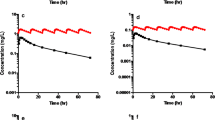Abstract
Many drugs with low oral bioavailability due to substantial first-pass hepatic loss form pharmacologically active metabolites. In such cases, the pharmacologic activity after oral administration is greater than anticipated from bioavailability data, based on chemical assay of drug alone. This paper explores the use and meaning of pharmacologic data to assess bioavailability under these circumstances. Two steady-state concepts are introduced: a metabolite-to-drug intravenous delivery rate potency ratioand an effective bioavailability,defined as the ratio of intravenous-to-oral delivery rates of drug required to produce the same response. Using a combined phar-macokinetic-pharmacodynamic model, the impact of various factors on the effective bioavailability and on its estimation, using the intravenous-to-oral dose ratio required to produce the same area under the response time curve after acute administration, are explored. It is proposed that attention be centered more on comparison of rates of administration, or doses, that produce equal responses than on bioavailability per se.
Similar content being viewed by others
References
V. F. Smolen and W. A. Weigand. Drug bioavailability and pharmacokinetic analysis from pharmacological data.J. Pharmacokin. Biopharm. 1:329–337 (1973).
V. F. Smolen. Theoretical and computational basis for drug bioavailability determinations using pharmacological data. I. General considerations and procedures.J. Pharmacokin. Biopharm. 4:337–353 (1976).
Code of (USA) Federal Regulations.Bioavailability and Bioequivalence Requirements, Vol. 21. Part 320.
S. Pond and T. N. Tozer. First pass elimination: Basic concepts and clinical consequences.Clin. Pharmacokin. 9:1–25 (1984).
B. Ablad, K. O. Borg, G. Johnsson, C-G. Regärdh, and L. Sölvell. Combined pharmacokinetic and pharmacodynamic studies of alprenolol and 4-hydroxy-alprenolol in man.Life Sci. 14:693–700 (1974).
N. H. G. Holford and L. B. Sheiner. Kinetics of pharmacological response.Pharmacol. Ther. 16:143–166 (1982).
N. H. G. Holford, P. E. Coates, T. W. Güntert, S. Riegelman, and L. B. Sheiner. The effect of quinidine and its metabolites on the electrocardiogram and systolic time intervals: concentration-effect relationship.Br. J. Clin. Pharmacol. 11: 187–195 (1981).
D. J. Coltart and D. G. Shand. Plasma propranolol levels in the quantitative assessment of β-adrenergic blockade in man.Br. Med. J. 3:731–734 (1970).
E. Müller-Schweinitzer. Pharmacological actions of the main metabolites of dihydroergotamine.Eur. J. Clin. Pharmacol. 26:699–705 (1984).
H. Echizen, B. Vogelgesang, and M. Eichelbaum. Effects of d, 1-verapamil on atrioventricular conduction in relation to its stereoselective first-pass metabolism.Clin. Pharmacol. Ther. 38:71–76 (1985).
L. Martis and R. Levy. Bioavailability calculations for drugs showing simultaneous first-order and capacity limited elimination kinetics.J. Pharmacokin. Biopharm. 1:283–294 (1973).
J. B. Houston. Drug metabolite kinetics.Pharmacol. Ther. 15:521–552 (1981).
G. Levy. Variability in animal and human pharmacodynamic studies. In M. Rowland, L. B. Sheiner and J-L. Steimer, (eds.),Variability in Drug Therapy, Raven Press, New York, 1985, pp. 125–138.
V. F. Smolen, H. R. Murdock, W. P. Stolman, J. W. Clevenger, L. W. Combs, and E. J. Williams. Pharmacological response data for comparative bioavailability studies for chlorpromazine oral dosage forms in humans. 1. Pupilometry.J. Clin. Pharmacol. 15:734–751 (1975).
H. Möller, U. Gundert-Remy, and W. Stüber. Bioäquivalenz von clonidin-retard präparaten mit hilfe der pharmokokinetik under pharmakodynamik.Pharm. Ind. 47: 93–98 (1985).
H. Blume, G. Stenzhorn, and S. L. Ali. Zur bioverfugbarkeit und pharmakodynamischen aktivität handelsüblicher glibenclamid-fertigarzneimittel.Pharmazeut. Zeit. 130: 1062–1069 (1985).
Author information
Authors and Affiliations
Additional information
An erratum to this article is available at http://dx.doi.org/10.1007/BF01062275.
Rights and permissions
About this article
Cite this article
Rowland, M. Bioavailability assessment and pharmacologie response: Impact of first-pass loss when both drug and metabolites are active. Journal of Pharmacokinetics and Biopharmaceutics 16, 573–593 (1988). https://doi.org/10.1007/BF01062013
Received:
Revised:
Published:
Issue Date:
DOI: https://doi.org/10.1007/BF01062013




